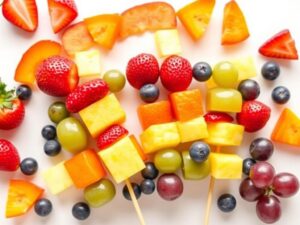Eat Your Way to Fabulous Skin
Did you know that 73% of people who added vitamin C-rich foods to their diet saw a visible improvement in skin texture within three months? Your skin is the body’s largest organ, and what you eat directly impacts its health. From glowing radiance to reducing breakouts, the right foods for skin can transform your complexion from the inside out.

Nutrients like antioxidants in berries and omega-3s in salmon don’t just fuel your body—they repair and protect skin cells. A balanced diet packed with these essentials can reduce wrinkles, even out tone, and boost natural hydration. Plus, we’ll share a FREE 7-day plan to help you start nourishing your skin today!
Key Takeaways
- 73% of people improved skin texture by eating vitamin C-rich foods for skin.
- Antioxidants in foods like spinach and tomatoes fight aging free radicals.
- Omega-3 fatty acids from walnuts and flaxseeds strengthen skin barriers.
- A nutrient-rich diet can reduce acne and inflammation naturally.
- Our free meal plan shows how to combine these foods for radiant skin.
Introduction to Skin Nutrition
Your skin is more than just a shield. It’s a living system that needs the right fuel to stay healthy. Every day, it faces off against pollution, UV rays, and other stressors. The right nutrients can act as a protective shield, keeping your skin looking vibrant and strong.
Antioxidants are at the forefront of this battle. They fight off free radicals, which are unstable molecules that can cause early aging. Think of them as tiny warriors protecting your cells from harm. Studies have shown that eating foods rich in antioxidants can lead to smoother, brighter skin.
“A well-nourished diet supports skin from the inside out,” says a 2022 study in the Journal of Dermatological Science.
- Blueberries: Packed with vitamin C and antioxidants to boost collagen.
- Spinach: Loaded with lutein, an antioxidant that shields skin from sun damage.
- Dark chocolate: Contains flavonoids that improve skin hydration and texture.
Nutrients like vitamins A, C, and E work together with antioxidants to repair and rejuvenate your skin. By choosing foods rich in these, you’re giving your skin the tools it needs to fight aging and stay healthy. Next, we’ll dive into how specific foods can directly impact your skin’s appearance.
The Connection Between Diet and Healthy Skin
Your diet is more than just fuel for your body. It plays a big role in how your skin looks and feels. Nutrients like omega-3 fatty acids and vitamins are like building blocks for your skin’s structure and health.
Understanding the Impact of Nutrients
Omega-3 fatty acids help reduce inflammation that can cause acne and wrinkles. They also make your skin more hydrated and elastic. For instance, studies show that omega-3s in foods like salmon and walnuts help fight dryness and improve skin barrier function.

How Foods for Skin Improve Your Complexion
Here’s how common foods make a difference:
- Fatty fish (like salmon) supply omega-3 to plump skin cells.
- Leafy greens deliver antioxidants to combat aging.
- Nuts and seeds add zinc, which fights blemishes.
| Nutrient | Food Sources | Skin Benefits |
|---|---|---|
| Omega-3 | Salmon, chia seeds | Reduces redness, boosts moisture |
| Vitamin C | Oranges, bell peppers | Encourages collagen growth |
| Zinc | Pumpkin seeds, yogurt | Regulates oil production |
Eating these foods regularly can transform your skin’s texture and radiance. Your plate is where beauty begins!
Exploring Foods for Skin Health
Choosing the right foods can change how your skin looks. Look for foods full of nutrients that fight aging and inflammation. Start with foods rich in antioxidants to protect your skin from harm.
Top Foods Rich in Antioxidants
- Berries like blueberries and strawberries fight free radicals that harm skin cells.
- Dark leafy greens such as spinach and kale boost skin barrier function with beta-carotene.
- Nuts like almonds and walnuts give vitamin E, an antioxidant that keeps skin hydrated.
Everyday Ingredients That Boost Skin Glow
Simple swaps in your kitchen can make a big difference. Try:
- Adding avocado to smoothies for healthy fats that improve skin elasticity.
- Including tomatoes in salads—they’re rich in lycopene, which protects against sun damage.
- Snacking on dark chocolate (70% cocoa or higher) for flavonoids that promote skin density.
“A diet high in plant-based nutrients directly impacts skin vitality,” says Dr. Emily Carter, a dermatologist specializing in nutritional skincare. “Prioritizing these foods supports collagen production and a radiant complexion.”
Add these options to meals like spinach salads, nut-based trail mix, or grilled salmon with tomato salsa. Small changes in nutrition can lead to visible improvements in your skin’s texture and tone.
The Role of Antioxidants in Nourishing Your Skin
Antioxidants protect your skin from damage. They fight off free radicals from pollution, UV rays, and stress. When you add skin vitamins like C and E, they work even better. Together, they slow down aging and help make more collagen.
Here’s how they help:
- Vitamin C brightens dull skin and helps make collagen (found in oranges, bell peppers, and kale).
- Vitamin E protects skin from sun damage and fixes moisture barriers (present in almonds, sunflower seeds, and spinach).
- Together, they fight wrinkles and even out skin texture.

Eating foods rich in antioxidants like berries, dark chocolate, and green tea can help. They reduce redness and make skin more elastic. To get the most benefits, mix foods: add lemon to spinach salads or eat nuts with citrus.
This way, skin vitamins are absorbed better, making every meal a beauty treatment.
Protecting your skin starts from within. By focusing on antioxidants and their vitamin friends, you’re not just eating well. You’re also investing in a glowing complexion.
Incorporating Omega-3 into Your Diet for Fabulous Skin
Omega-3 fatty acids are key for healthy skin. They reduce inflammation and boost elasticity. These nutrients fight dryness and improve skin texture. They are a must in your foods for skin routine.
Whether you like fish or plant-based foods, adding omega-3 is simple. You can use everyday ingredients.
Benefits of Omega-3 for Skin Elasticity
Omega-3 fatty acids work in three main ways:
- They reduce redness and soothe breakouts caused by inflammation.
- They lock in moisture to prevent flaky or tight skin.
- They strengthen the skin’s natural barrier against environmental damage.
Quick Recipes for Omega-3 Rich Meals
Try these easy dishes to increase your omega-3 intake:
- Salmon & Avocado Bowl: Sauté wild-caught salmon with garlic and lemon. Layer on a bed of spinach, add avocado slices, and drizzle with olive oil.
- Chia Seed Smoothie: Blend frozen blueberries, almond milk, and 1 tbsp chia seeds. Let it sit 5 minutes to thicken into a creamy, nutrient-packed drink.
- Walnut Stuffed Sweet Potatoes: Roast a sweet potato. Mix chopped walnuts, Greek yogurt, and cinnamon. Fill the potato and top with a sprinkle of flaxseeds.
Pairing these foods for skin with other antioxidants boosts results. Small changes, like using flaxseed oil instead of butter, can make a big difference. Your skin will start to glow in weeks with consistent choices.
Essential Skin Vitamins and Their Benefits
Vitamins A, C, and E are key for your skin. Vitamin A helps cells renew, making skin smooth. Vitamin C boosts collagen, keeping skin tight. Vitamin E fights off damage from the environment.
Together, these vitamins repair, protect, and refresh your skin.
- Vitamin A: Found in sweet potatoes and carrots, it aids in skin renewal.
- Vitamin C: Citrus fruits and bell peppers fuel collagen, reducing wrinkles.
- Vitamin E: Nuts and seeds contain antioxidants that guard against sun damage.
A 2023 study in the Journal of Dermatology noted that diets rich in vitamins A, C, and E reduce UV-induced damage by up to 25%.

Adding antioxidants from foods like spinach and berries boosts these vitamins’ effects. A morning smoothie with mango (vitamin C), avocado (vitamin E), and kale (vitamin A) is a nutrient powerhouse. Eating whole foods is best for your skin’s health.
Nutrition and Skin: Creating a Balanced Diet
Creating a diet for your skin starts with balance. The right mix of nutrients is key for a glowing complexion. Here’s how to make meals that are good for your skin:
Building a Meal Plan for Radiant Skin
Think of your plate as a canvas. Daily, combine these elements:
- Lean proteins like grilled chicken or tofu for collagen support
- Colorful veggies packed with antioxidants (think spinach, bell peppers)
- Healthy fats such as avocado or walnuts, rich in omega-3 for moisture
- Whole grains like quinoa for sustained energy
Balancing Macronutrients and Micronutrients
Macros and micronutrients work together:
- Proteins: Repair skin cells (try eggs or lentils)
- Fats: Include omega-3 sources like flaxseeds to reduce inflammation
- Carbs: Opt for fiber-rich options like sweet potatoes
Micronutrients like vitamin C (in citrus) and zinc (in nuts) boost glow. Mix and match to create meals that nourish inside and out.
Meal Planning for Radiant Skin
Meal planning is key to balancing nutrition and skin health. By focusing on nutrient-dense foods, you can boost your complexion and energy naturally. Start your day right with these easy ideas.
Healthy Breakfast Ideas
- Oatmeal topped with blueberries and almonds: packed with antioxidants and healthy fats
- Spinach and feta frittata with whole-grain toast: rich in vitamin E and protein
- Smoothie blends (kale, banana, chia seeds, almond milk): delivers vitamins and hydration
Lunch and Dinner Options
Pair lean proteins with colorful veggies for optimal skin support:
| Meal Component | Example Foods | Skin Benefits |
|---|---|---|
| Protein | Grilled salmon, turkey, tofu | Strengthens skin barrier and reduces inflammation |
| Vegetables | Kale, broccoli, bell peppers | Rich in vitamins C and E for collagen production |
| Grains | Quinoa, brown rice, farro | Stable energy and fiber for detox support |
Example weekly plan: Monday—salmon salad, Tuesday—turkey wraps with avocado, Wednesday—quinoa bowls with roasted veggies. Mix ingredients to suit your schedule.
The Science Behind Nutrient Absorption and Skin Health
Your body’s ability to absorb vitamins and minerals is key to skin health. Vitamins like A, C, and E need to be digested well to work. If you eat nutrient-rich foods but don’t absorb them, your skin won’t glow as much.
Gut health is the hidden hero here. A healthy gut breaks down food, letting vitamins into your blood. Foods like yogurt or sauerkraut with probiotics help your gut. Also, foods high in fiber, like spinach or quinoa, keep things moving and nutrients absorbed.
- Boost absorption with: Pair vitamin C-rich citrus with iron sources like lentils (C helps iron absorb better).
- Avoid: Excess caffeine or alcohol, which can block nutrient uptake.
Stress or poor sleep can slow digestion. Even with a good diet, stress might stop your skin from using vitamins. Eating well and staying hydrated and well-rested helps your skin vitamins work best.
Customizing Your Skincare Routine with Dietary Tips
Choosing the right foods can make your skincare routine better. Experts say to match your diet with your skincare products. Pick foods for skin that go well with what you’re using.

Integrating Supplements with Nutrition
Supplements like vitamin C and zinc work best with a healthy diet. For example, taking collagen supplements with salmon or chia seeds makes them more effective. Look for brands like Neutrogena or Olay that talk about how nutrients work together.
Identifying Foods That Complement Skincare Products
- Pair retinol creams with vitamin E-rich foods like almonds to reduce irritation.
- Use hyaluronic acid serums alongside water-dense foods such as cucumbers for plumper skin.
- Combine antioxidant serums with berries or dark chocolate to boost cellular repair.
“A diet rich in omega-3s can enhance the absorption of moisturizers, creating a dual-layer hydration effect.”
Customizing your skincare means watching how foods for skin work with your products. Try adding ingredients like turmeric or green tea for seasonal changes. Making small diet changes can make your skincare routine much stronger.
Debunking Myths About Diet and Skin Health
Myths about food and skin care can confuse your path to glowing skin. Let’s clear up the confusion. Many think crash diets solve skin problems fast. But, extreme diets can harm your body, taking away important nutrients like antioxidants needed for healing.
“Skin health thrives on consistency, not quick fixes,” says dermatologist Dr. Emily Carter.
High-GI carbs, like sugary snacks, can hurt your skin over time. But, cutting all carbs is not the solution. Instead, choose complex carbs with antioxidant-rich foods. Another myth is that just using topical products will fix everything. Healthy skin needs both skincare and a diet full of vitamins and antioxidants to work from the inside out.
- Myth 1: Skipping meals boosts skin clarity. Fact: Starvation diets slow metabolism and reduce collagen production.
- Myth 2: All fats damage skin. Fact: Omega-3s and olive oil protect skin cells while antioxidants neutralize harmful free radicals.
- Myth 3: Supplements replace whole foods. Fact: Real foods like berries and spinach deliver antioxidants alongside fiber and minerals.
Forget extremes. Focus on balance—eat colorful fruits, leafy greens, and healthy fats. Your skin needs science-backed care, not just trends.
Success Stories: Transforming Your Complexion Naturally
Real people across the U.S. have seen big changes by choosing skin-friendly foods. Here’s how they made science work for them.

Real-Life Experiences from the United States
Sarah from California changed her diet to include salmon and walnuts. In six months, her acne disappeared, and her skin shone. “Adding omega-3 foods made the biggest difference,” she said.
Michael, a New Yorker, added flaxseeds to his green smoothies. His doctor noticed better skin elasticity after a year.
“I never thought eating chia seeds could smooth my wrinkles!” — Lisa, Texas
Practical Strategies That Worked
Here are the strategies that helped them:
- Eat omega-3 sources like fatty fish twice a week.
- Pair meals with antioxidant-rich veggies for balanced nutrition.
- Track progress with weekly photos to stay motivated.
These stories show how small diet changes can make a big difference. Focus on making healthy choices. Your skin will appreciate it.
Conclusion
Your skin’s health starts with the foods you choose daily. Eating foods rich in nutrition and skin care vitamins like C and E is key. These vitamins protect your skin and make it glow.
Antioxidant-rich foods like berries, leafy greens, and nuts help keep your skin hydrated and firm. Omega-3 sources like salmon or flaxseeds also play a big role.
Small changes can make a big difference. Try swapping processed snacks for almonds or sugary drinks for green tea. This boosts your intake of skin vitamins and reduces inflammation.
There’s no one-size-fits-all approach. Find meals that fit your lifestyle, like chia pudding for breakfast or a spinach salad with walnuts for lunch.
Consistency is key to seeing results. Those who made dietary changes and added gentle skincare habits saw improvements. If you’re not sure where to start, track your meals for a week to find gaps.
Consult a dermatologist or dietitian for advice on specific concerns like dryness or redness.
Great skin isn’t just about what you put on your face. It’s about the nutrients you eat. Use your plate as a beauty toolkit. Focus on whole foods and mindful eating for a glowing complexion.
Start small, stay curious, and let your diet be your first step toward a healthier you.

Adam Peter is a finance, travel, and automotive writer with over a decade of experience. He creates clear, practical content to help readers manage their money, explore the world with confidence, and make informed decisions about cars and travel gear. His work blends expert insight with real-world usefulness.



